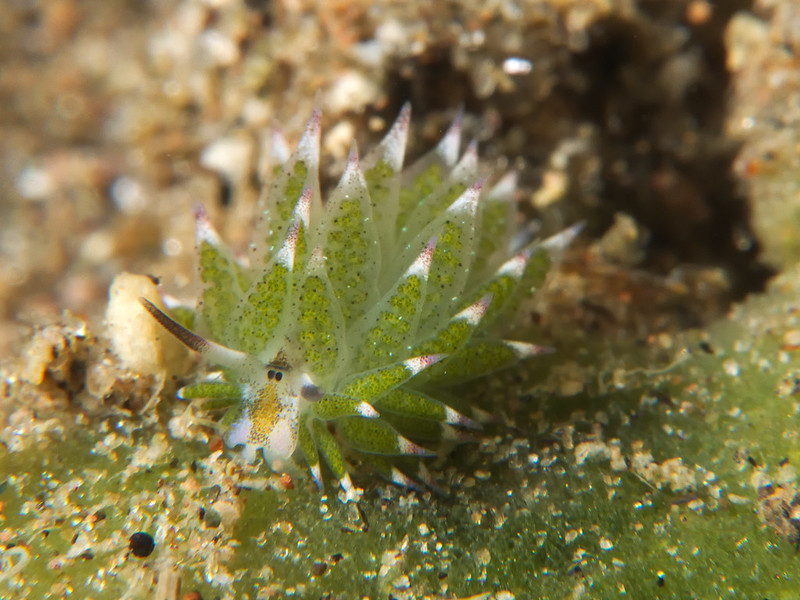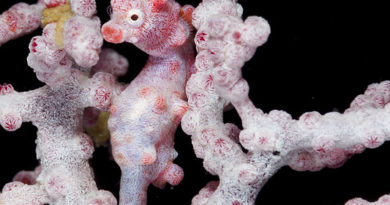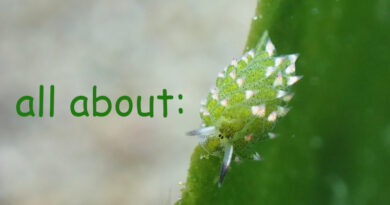Marine Bio Journal Club: Stealing Chloroplasts
A highly interesting paper just came out which answered a curious scientific question, how certain species of sea slug can continue to use the chloroplasts – the photosynthetic parts of algal cells – AFTER feeding on these algae. The chloroplasts are still active when in the body of the slug. This is akin a human eating an salad, and the salad then still growing while in a part of the digestive system of that person, with light which penetrates his skin. Very curious! This is one of these biological questions which pop up when studying the very diverse fauna – fish, mollusks, echinoderms, and many other groups – of the world’s oceans. Many groups of animals have evolved very particular tricks and quirks, and there is fascinating biology in these.
This is Costasiella sp., one of these algal-powered sea slugs. It’s a sacoglossan, not a nudibranch, but also a gastropod mollusk, like your garden slug, or the nudibranchs.
The phenomenon that certain sea slugs feed algae, but then keep their chloroplasts of these algae operational is called kleptoplasty (plastid-stealing; a plastid refers to the chloroplast). Now, how do these slugs make this happen? Specifically, did they take up some genes from the algae into their genomes? Because, the chloroplasts – cyanobacteria which eons ago became endosymbionts of algae – have lots most of their genes and moved them into the nucleus of the eukaryotic plant in which they exist.
So, the question now is, how are the chloroplasts maintained in their new – sea slug – host?
Are they being supplied with proteins from their host cell, just like when they are in the algal cell? In that case, some of the algal genes would have to have moved to the slug genome. Such horizontal gene transfer indeed happens frequently in nature, more often in bacteria than in “higher” organisms, but it happens there too. Then, these genes would give rise to structural proteins needed in the chloroplasts.
Or, the chloroplasts make do with the proteins which they contain when they are being transferred to the cells of the slug intestine.
It seems the latter is the case. The scientists found no algae to slug horizontal gene transfer when analyzing the complete genome of the “solar powered” sarcoglossan slug Plakobranchus ocellatus . Still, the chloroplasts functioned (up to 300 days in some slug species), and extended the lives of starving sea slugs. Instead of taking up genes from the algae, the sea slugs increased their genetic repertoire in terms of 1. immunity (= dealing with the foreign chloroplasts in their cells) 2. protein degradation (= taking out damaged photosynthetic proteins in the acquired chloroplasts which emit dangerous reactive oxygen molecules) and 3. carbohydrate metabolism (= important in cell-cell recognition).

This is the very well done and scholarly very solid paper:
Look at the figure from the paper above, sub-figure B (bottom right): This is the family tree of kleptoplastic sea slugs, where some of them are capable to maintain algal chloroplasts for extended periods of time, some for short time, and some can’t do it at all. There is no clear relation between belonging to a certain genus of sea slug (such as Elysia) and the ability to maintain “captive” chloroplasts. This suggests a complex pattern of gain and loss of the ability to maintain such chloroplasts by the slugs.
Curious!
Kleptoplastic Video
Check out my latest video featuring such a kleptoplastic sea slug, and neighbors:


